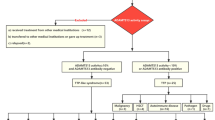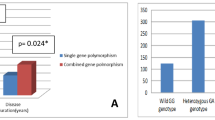Abstract
The aim of this study was to investigate the effect of C-reactive protein (CRP) on the prognosis of adult patients with Immune thrombocytopenia purpura (ITP). A retrospective study of 628 adult ITP patients, as well as 100 healthy and 100 infected patients, attending the Affiliated Hospital of Xuzhou Medical University from January 2017 to June 2022 was performed. The ITP patients were grouped according to their CRP levels, and the differences in clinical characteristics of each group and the influencing factors of efficacy in newly diagnosed ITP patients were analyzed. CRP levels were significantly higher in the ITP and infected groups compared with healthy controls (P < 0.001), and platelet counts were significantly lower in the ITP group (P < 0.001). Between the CRP normal and elevated group, their age, white blood cell count, neutrophil count, lymphocyte count, red blood cell count, hemoglobin, platelet count, complement C3 and C4, PAIgG, bleeding score, proportion of severe ITP, and proportion of refractory ITP were significantly different (P < 0.05). Patients of severe ITP (P < 0.001), refractory ITP (P = 0.002), and with active bleeding (P < 0.001) had significantly higher CRP levels. Patients with no response after treatment had significantly higher CRP levels than those who achieved CR or R (P < 0.001). Platelet counts (r = − 0.261, P < 0.001) in newly diagnosed ITP patients and treatment outcomes (r = − 0.221, P < 0.001) were negatively correlated with CRP levels, and bleeding score was positively correlated with CRP levels (r = 0.207, P < 0.001). Treatment outcome was positively correlated with decrease in CRP levels (r = 0.313, P = 0.027). A multifactorial regression analysis of the influencing factors of treatment outcomes on newly diagnosed patients found that CRP was an independent risk factor of the prognosis (P = 0.011). In conclusion, CRP can help assess the severity and predict the prognosis of ITP patients.







Similar content being viewed by others
References
Cooper N, Ghanima W. Immune thrombocytopenia. N Engl J Med. 2019;381(10):945–55.
Lynch DR, Stringham EN, Zhang B, et al. Anchoring IgG-degrading enzymes to the surface of platelets selectively neutralizes antiplatelet antibodies. Blood Adv. 2022;6(15):4645–56.
Lu J, Marjon KD, Mold C, Du Clos TW, Sun PD. Pentraxins and Fc receptors. Immunol Rev. 2012;250(1):230–8.
Thrombosis and Hemostasis Group CSoHCMA. Chinese guideline on the diagnosis and management of adult primary immune thrombocytopenia (version 2020). Zhonghua Xue Ye Xue Za Zhi. 2020;41(8):617–23.
Nehring SM, Goyal A and Patel BC, C Reactive Protein, in StatPearls. 2022, StatPearls Publishing Copyright© 2022, StatPearls Publishing LLC: Treasure Island (FL).
Sproston NR, Ashworth JJ. Role of C-reactive protein at sites of inflammation and infection. Front Immunol. 2018;9:754.
Lee Y, McKechnie T, Doumouras AG, et al. Diagnostic value of C-reactive protein levels in postoperative infectious complications after bariatric surgery: a systematic review and meta-analysis. Obes Surg. 2019;29(7):2022–9.
Johns I, Moschonas KE, Medina J, et al. Risk classification in primary prevention of CVD according to QRISK2 and JBS3 ‘heart age’, and prevalence of elevated high-sensitivity C reactive protein in the UK cohort of the EURIKA study. Open Heart. 2018;5(2):e000849.
Blake GJ, Ridker PM. Inflammatory bio-markers and cardiovascular risk prediction. J Intern Med. 2002;252(4):283–94.
Vítek L, Jirásková A, Malíková I, et al. serum bilirubin and markers of oxidative stress and inflammation in a healthy population and in patients with various forms of atherosclerosis. Antioxidants (Basel, Switzerland). 2022;11(11):2118.
Semple JW. C-reactive protein boosts antibody-mediated platelet destruction. Blood. 2015;125(11):1690–1.
Kapur R, Heitink-Pollé KMJ, Porcelijn L, et al. C-reactive protein enhances IgG-mediated phagocyte responses and thrombocytopenia. Blood. 2015;125(11):1793–802.
Campbell CL, Steinhubl SR, Hooper WC, et al. Bleeding events are associated with an increase in markers of inflammation in acute coronary syndromes: an ACUITY trial substudy. J Thromb Thrombolysis. 2011;31(2):139–45.
Di Napoli M, Godoy DA, Campi V, et al. C-reactive protein in intracerebral hemorrhage: time course, tissue localization, and prognosis. Neurology. 2012;79(7):690–9.
Di Napoli M, Parry-Jones AR, Smith CJ, et al. C-reactive protein predicts hematoma growth in intracerebral hemorrhage. Stroke. 2014;45(1):59–65.
Palandri F, Catani L, Auteri G, et al. Understanding how older age drives decision-making and outcome in Immune Thrombocytopenia. A single centre study on 465 adult patients. Br J Haematol. 2019;184(3):424–30.
Krémer V, de Chaisemartin L, Jönsson F. The role of neutrophils in antibody-driven autoimmune cytopenias. Int J Biochem Cell Biol. 2022;147:106231.
Verschoor A, Langer HF. Crosstalk between platelets and the complement system in immune protection and disease. Thromb Haemost. 2013;110(5):910–9.
Tsubakio T, Tani P, Curd JG, McMillan R. Complement activation in vitro by antiplatelet antibodies in chronic immune thrombocytopenic purpura. Br J Haematol. 1986;63(2):293–300.
Nagamine T, Ohtuka T, Takehara K, et al. Thrombocytopenia associated with hepatitis C viral infection. J Hepatol. 1996;24(2):135–40.
Hohmann AW, Booth K, Peters V, Gordon DL, Comacchio RM. Common epitope on HIV p24 and human platelets. Lancet (London, England). 1993;342(8882):1274–5.
Huang C-E, Chen W-M, Wu Y-Y, et al. Comparison of antiplatelet antibody profiles between hepatitis C virus-associated immune thrombocytopenia and primary immune thrombocytopenia. Platelets. 2021;32(8):1043–50.
Zhang W, Nardi MA, Borkowsky W, Li Z, Karpatkin S. Role of molecular mimicry of hepatitis C virus protein with platelet GPIIIa in hepatitis C-related immunologic thrombocytopenia. Blood. 2009;113(17):4086–93.
Wright JF, Blanchette VS, Wang H, et al. Characterization of platelet-reactive antibodies in children with varicella-associated acute immune thrombocytopenic purpura (ITP). Br J Haematol. 1996;95(1):145–52.
Li Z, Nardi MA, Karpatkin S. Role of molecular mimicry to HIV-1 peptides in HIV-1-related immunologic thrombocytopenia. Blood. 2005;106(2):572–6.
Takeuchi H, Okamoto A. Infection and chronic immune thrombocytopenia. J Clin Med. 2022;11(16):4822.
Han B, Kim HJ, Yhim H-Y, et al. Sequential eradication of Helicobacter pylori as a treatment for immune thrombocytopenia in patients with moderate thrombocytopenia: a multicenter prospective randomized phase 3 study. Ann Hematol. 2022;101(7):1435–45.
Funding
This work was supported by grants from the National Natural Science Foundation of China (82070127).
Author information
Authors and Affiliations
Contributions
HC, KX, WC diagnosed the ITP patients, designed the research study. YZ, FL and XL analyzed the results and wrote the manuscript; JZ, LH and XS followed up the patients; JC and ZL reviewed and critically edited the manuscript.
Corresponding authors
Ethics declarations
Conflict of interest
No relevant conflicts of interest are related to this study.
Additional information
Publisher's Note
Springer Nature remains neutral with regard to jurisdictional claims in published maps and institutional affiliations.
Rights and permissions
Springer Nature or its licensor (e.g. a society or other partner) holds exclusive rights to this article under a publishing agreement with the author(s) or other rightsholder(s); author self-archiving of the accepted manuscript version of this article is solely governed by the terms of such publishing agreement and applicable law.
About this article
Cite this article
Zhang, Y., Liu, F., Liang, X. et al. Expression and prognostic value of C-reactive protein in adult immune thrombocytopenia (ITP) patients. Clin Exp Med 23, 4483–4491 (2023). https://doi.org/10.1007/s10238-023-01043-y
Received:
Accepted:
Published:
Issue Date:
DOI: https://doi.org/10.1007/s10238-023-01043-y




